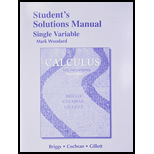
Concept explainers
Interpreting directional derivatives A function f and a point P are given. Let θ correspond to the direction of the directional derivative.
- a. Find the gradient and evaluate it at P.
- b. Find the angles θ (with respect to the positive x-axis) associated with the directions of maximum increase, maximum decrease, and zero change.
- c. Write the directional derivative at P as a function of θ; call this function g.
- d. Find the value of θ that maximizes g(θ) and find the maximum value.
- e. Verify that the value of θ that maximizes g corresponds to the direction of the gradient. Verify that the maximum value of g equals the magnitude of the gradient.
38.
Want to see the full answer?
Check out a sample textbook solution
Chapter 12 Solutions
Student Solutions Manual, Single Variable for Calculus: Early Transcendentals
Additional Math Textbook Solutions
Pre-Algebra Student Edition
A Problem Solving Approach To Mathematics For Elementary School Teachers (13th Edition)
College Algebra (7th Edition)
A First Course in Probability (10th Edition)
Calculus: Early Transcendentals (2nd Edition)
- Cable AB is 103 ft long and the tension in the cable is 3900 lb. 56 ft D y A B 20° 50° x C Identify the x, y, and z components of the force exerted by the cable on the anchor B. 1 F. FI 3 Fy 2 Match each of the options above to the items below. 2,120 lb 1,120 lb -3,076 lbarrow_forwardIn the given figure, P = 51 lb. 65° 25° 35° 75 lb P B Determine the required tension in cable AC, knowing that the resultant of the three forces exerted at point C of boom BC must be directed along BC. The required tension in cable AC is lb.arrow_forwardhelp on this question about Laplace transformation?arrow_forward
- Help me expand this fraction below.arrow_forwarddetermine the final and initial value of the expression below: Helparrow_forwardThe boom OA carries a load P and is supported by two cables as shown. Knowing that the tension in cable AB is 190 lb and that the resultant of the load P and of the forces exerted at A by the two cables must be directed along OA, determine the tension in cable AC. 29 in. B 24 in. 36 in. C 25 in. 48 in.. Aarrow_forward
- Find the distance (d) from the point (8, -7, -1) to the plane 3x+5y-3z = -60.arrow_forwardThe 60-lb collar A can slide on a frictionless vertical rod and is connected as shown to a 65-lb counterweight C. Draw the free-body diagram of the collar that is needed to determine the value of h for which the system is in equilibrium. -15 in. A 60 lb B C h 65 lbarrow_forwardTwo cables tied together at Care loaded as shown. Given: Q = 130 lb. 30° C B Determine the range of values of P for which both cables remain taut. lbarrow_forwardFind the parametric equation for the line where the planes -4x+y+3x= -11 and -2x+y=3z = 7 intersect.arrow_forwardDo the Laplace Transformation and give the answer in Partial Fractions. Also do the Inverted Laplace Transformation and explain step-by-step.arrow_forwardDo the Laplace Transformation and give the answer in Partial Fractions. Also do the Inverted Laplace Transformation and explain step-by-step.arrow_forwardarrow_back_iosSEE MORE QUESTIONSarrow_forward_ios
- Algebra & Trigonometry with Analytic GeometryAlgebraISBN:9781133382119Author:SwokowskiPublisher:Cengage
 College Algebra (MindTap Course List)AlgebraISBN:9781305652231Author:R. David Gustafson, Jeff HughesPublisher:Cengage Learning
College Algebra (MindTap Course List)AlgebraISBN:9781305652231Author:R. David Gustafson, Jeff HughesPublisher:Cengage Learning Mathematics For Machine TechnologyAdvanced MathISBN:9781337798310Author:Peterson, John.Publisher:Cengage Learning,
Mathematics For Machine TechnologyAdvanced MathISBN:9781337798310Author:Peterson, John.Publisher:Cengage Learning,  Algebra: Structure And Method, Book 1AlgebraISBN:9780395977224Author:Richard G. Brown, Mary P. Dolciani, Robert H. Sorgenfrey, William L. ColePublisher:McDougal Littell
Algebra: Structure And Method, Book 1AlgebraISBN:9780395977224Author:Richard G. Brown, Mary P. Dolciani, Robert H. Sorgenfrey, William L. ColePublisher:McDougal Littell



